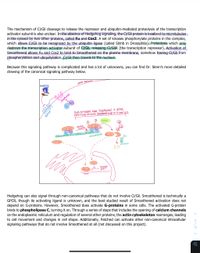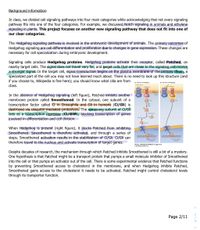
Concept explainers
For each of the following, describe the path the protein takes to its final destination in the cell.
Drawings are strongly recommended! If you need more space, you can use a separate sheet of
paper. Proteins: 1) Hedgehog (released from the signaling cell), 2) Smoothened, 3) Ci/Gli
Your answers should include the following if they apply for each protein:
o Sorting sequences and how the protein knows where to go at each step (what recognizes
different sorting sequences/tags). How/when the protein is inserted into the membrane (if it is a membrane protein) What organelles the protein passes through on its way to its final destination. How the protein is transported (vesicles? translocons? etc.), including a role for microtubules.How the protein might be modified in each organelle it passes through. What other proteins are involved in transport and how the system is reset to allow for other
proteins to be transported.


Step by stepSolved in 3 steps with 19 images

- Define upstream processing when producing a protein and list two examples. Cite it.arrow_forwardWhat is the major driving force that works in favor of tertiary protein structure formation (protein folding) and when does it occur (what are the conditions)?arrow_forwardWhat types of amino acids are the least likely to be found in the center of a transmembrane protein? Why?arrow_forward
- what is the difference between a ligand and a domain? I understand they both attach with proteins but how do u identify which is which? Also, what is the difference between the function of the two?arrow_forwardFill out the following table for the type of RNA that fits with the description. There are three main types of RNA, each of them has a specific role within the cell. The following table provides a list of statements in the left-hand column describing each of those three main types. In the right-hand column, select which type of RNA each statement describes. The choices for Type of RNA are: mRNArRNAtRNAarrow_forwardI need an example to study for an testarrow_forward
- A lysine is burined inside a protein surrounded by hydrophobic resiudes, how does this affect the pKa of lysine?arrow_forwardThe activity provides you with a version of the NGF pathway, an example of a RTK. All of the proteins involved can be in ON/OFF states. Using this cell signaling pathway you will be asked a variety of questions to determine how the molecules are regulated, but also how a cell would respond if this cell signaling party steps were interrupted or activated. Neural Growth Factir (NGF) Ras- Ras- GDP GTP Trk-A Ras-GEF braf braf МЕК МЕК ERK ERK ERK ERK STAT STAT Spiouty DNA Nucleus Cytosolarrow_forwardIn eukaryotic cells, ribosomes are found both free in the cytosol and attached to the endoplasmic reticulum (ER). Proteins produced on the attached ribosomes are delivered to the ER, while proteins produced on free ribosomes are delivered to the cytosol. Briefly explain in one or two sentences the two processes in terms of the following: • ONE ultimate destination of a protein produced on an attached ribosome, and ONE general function of the protein (You do not need to identify the specific protein.) • ONE ultimate destination of a protein produced on a free ribosome, and ONE general function of the protein (You do not need to identify the specific protein.)arrow_forward
- Are these true or false answers correct? If so, what is the proper word to replace the underlined words, for the false.arrow_forwardA peptide with the sequence AELQAKSAIAHELQAKAAIAHA is treated with ATP while in the presence of kinase An alpha helix is formed with the phosphorylated at pH 5 In the direction of the helix axis, what is the length of the helixarrow_forwardI'm a bit confused about this question will someone help me understand the conceptarrow_forward
 Human Anatomy & Physiology (11th Edition)BiologyISBN:9780134580999Author:Elaine N. Marieb, Katja N. HoehnPublisher:PEARSON
Human Anatomy & Physiology (11th Edition)BiologyISBN:9780134580999Author:Elaine N. Marieb, Katja N. HoehnPublisher:PEARSON Biology 2eBiologyISBN:9781947172517Author:Matthew Douglas, Jung Choi, Mary Ann ClarkPublisher:OpenStax
Biology 2eBiologyISBN:9781947172517Author:Matthew Douglas, Jung Choi, Mary Ann ClarkPublisher:OpenStax Anatomy & PhysiologyBiologyISBN:9781259398629Author:McKinley, Michael P., O'loughlin, Valerie Dean, Bidle, Theresa StouterPublisher:Mcgraw Hill Education,
Anatomy & PhysiologyBiologyISBN:9781259398629Author:McKinley, Michael P., O'loughlin, Valerie Dean, Bidle, Theresa StouterPublisher:Mcgraw Hill Education, Molecular Biology of the Cell (Sixth Edition)BiologyISBN:9780815344322Author:Bruce Alberts, Alexander D. Johnson, Julian Lewis, David Morgan, Martin Raff, Keith Roberts, Peter WalterPublisher:W. W. Norton & Company
Molecular Biology of the Cell (Sixth Edition)BiologyISBN:9780815344322Author:Bruce Alberts, Alexander D. Johnson, Julian Lewis, David Morgan, Martin Raff, Keith Roberts, Peter WalterPublisher:W. W. Norton & Company Laboratory Manual For Human Anatomy & PhysiologyBiologyISBN:9781260159363Author:Martin, Terry R., Prentice-craver, CynthiaPublisher:McGraw-Hill Publishing Co.
Laboratory Manual For Human Anatomy & PhysiologyBiologyISBN:9781260159363Author:Martin, Terry R., Prentice-craver, CynthiaPublisher:McGraw-Hill Publishing Co. Inquiry Into Life (16th Edition)BiologyISBN:9781260231700Author:Sylvia S. Mader, Michael WindelspechtPublisher:McGraw Hill Education
Inquiry Into Life (16th Edition)BiologyISBN:9781260231700Author:Sylvia S. Mader, Michael WindelspechtPublisher:McGraw Hill Education





